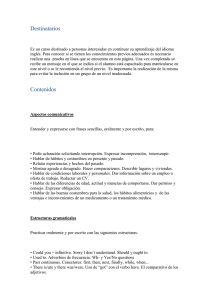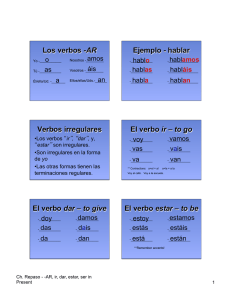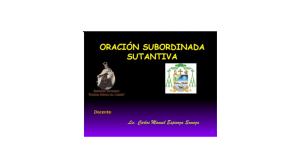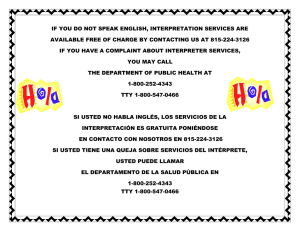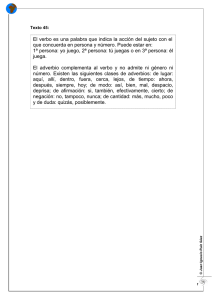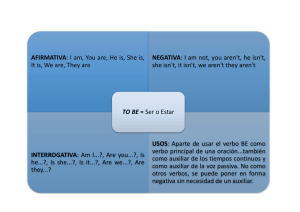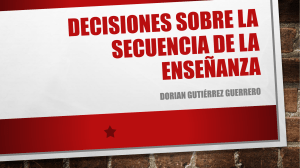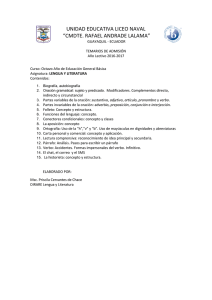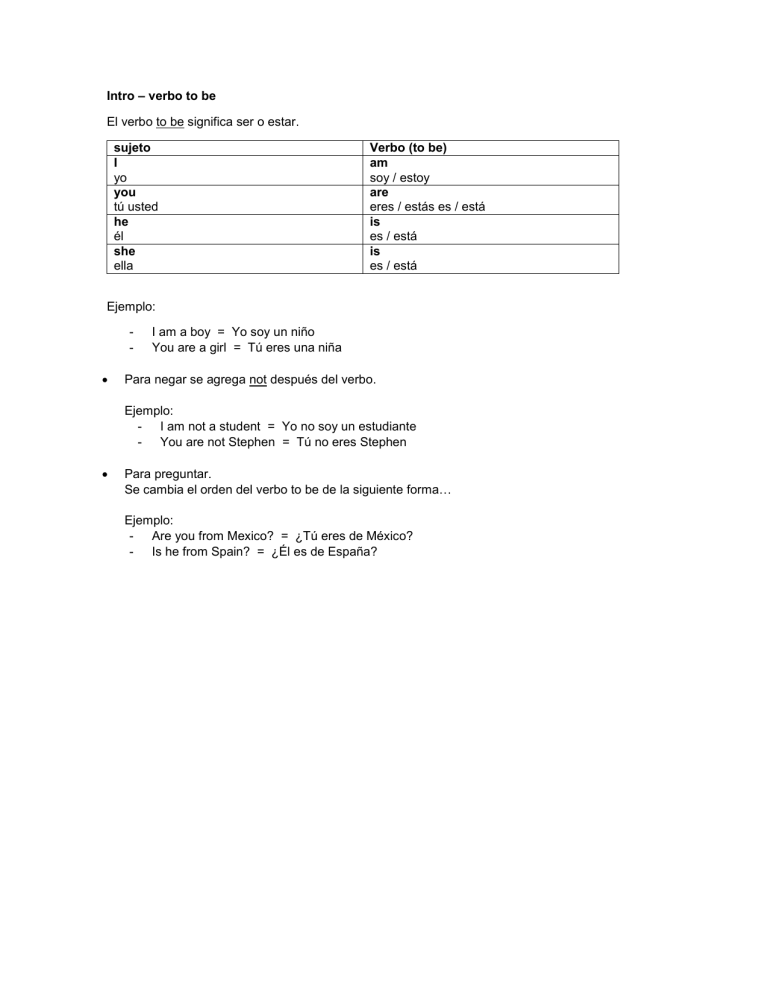
Intro – verbo to be El verbo to be significa ser o estar. sujeto I yo you tú usted he él she ella Verbo (to be) am soy / estoy are eres / estás es / está is es / está is es / está Ejemplo: I am a boy = Yo soy un niño You are a girl = Tú eres una niña Para negar se agrega not después del verbo. Ejemplo: - I am not a student = Yo no soy un estudiante - You are not Stephen = Tú no eres Stephen Para preguntar. Se cambia el orden del verbo to be de la siguiente forma… Ejemplo: - Are you from Mexico? = ¿Tú eres de México? - Is he from Spain? = ¿Él es de España? Saludos. How are you? = ¿Como estás? I am Good, thanks! = Estoy bien, ¡gracias! Welcome! = ¡Bienvenido! Recuerda que para hacer pregunta con to be, se cambia el orden del verbo to be. Ejemplo: - Cuando el verbo no es to be, se debe agregar do al inicio. - Are you from Spain? = Tú eres de España? Ejemplo: Do you speak English? = ¿Tú hablas inglés? Para negar cuando el verbo no es to be se debe agregar do not antes del verbo. Ejemplo: - I do not Speak English = Yo no hablo inglés Viajes. Where is….? = ¿Dónde está…? Where is the restroom? = ¿Dónde está el baño? Where is your Passport? = ¿Dónde está su pasaporte? I need a taxi = Yo necesito un taxi You speak Spanish = Tú hablas Español Menú Check, please = ¡La cuenta, por favor! I want to pay = Yo quiero pagar. Generalmente un adjetivo (describe algo) se usa antes del sustantivo (nombre de algo) que está describiendo. - A small Coffee = Un café pequeño Tambien pasa algo parecido cuando un sustantivo describe a otro. - A meat sándwich = Un sándwich de carne Encuentros Para hacer preguntas como ¿Dónde vive usted?, se usa una palabra interrogativa como Where y what, seguida por do o does. Ejemplo: - Where do you live? = ¿Dónde vives? What do you need? = ¿Qué necesitas? Familia Sujeto I yo Verbo (to have) have tengo you tú usted ustedes he/ she él / ella have tienes tiene tienen has tiene they ellos / ellas have tienen Ejemplo: - I have a sister = Yo tengo una hermana Empleos - I am a doctor = Yo soy doctor She is an English teacher = Ella es maestra de ingles - I work at a university = Yo trabajo en una universidad I live in Canada = Yo vivo en Canada Se usa at cuando se habla del lugar donde trabajas Se usa in cuando hablas del lugar donde vives Presente 1 Verbo to be (ser y estar) sujeto Verbo (be) I am you are He / she is Para preguntar con be… Are you a student? = ¿Tú eres estudiante? Tienda Diferenciar entre una cosa y muchas cosas funciona igual que en español. ¡Simplemente agrega una s al final! singular plural dog dogs perro perros table tables mesa mesas taxi taxis taxi taxis Ejemplo: - I need two taxis = Yo necesito dos taxis You need coffee = Tú necesitas café Mi día Where is…? = ¿Dónde está…? Ejemplo: Where is the restroom? = ¿Dónde está el baño? Where is my Passport? = ¿Dónde está mi pasaporte? Gustos
